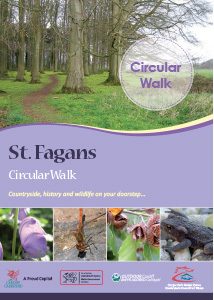The route of this circular walk is largely flat with some very gentle slopes. The walk is accessed from this point via a kissing gate, but users should be aware that there are three stiles situated along the route.
Way-markers are posted on this route for walkers to follow. The entire circular walk is just less than 2 miles in length (3km) and depending how fast you walk should take between ¾ and 1½ hours to complete.
Due to a number of routes being available in this area, the way-markers for this circular walk have a unique colour banding and a chronological reference. Users should also note that the northern point of this route involves walking on a roadside verge. As such, normal respect for the highway should be applied at all times.
Refreshments, toilet and car parking facilities are conveniently located at the National History Museum and the nearby the Plymouth Arms.

The St. Fagans area is rich in biodiversity. The main habitats of interest are the River Ely, together with the numerous woodlands and ponds. The river itself is a Site of Importance for Nature Conservation (SINC). Otters, Dippers, Kingfishers and Sand Martins are examples of some of the special creatures that use the river. It is also the Welsh stronghold of Monkshood, a large poisonous plant with blue flowers.
The woodlands in the area are mainly Beech, where you can find ancient woodland ground flora under the trees. In the spring this includes carpets of Bluebells, Ramsons (wild garlic), Lesser Celandine and Wood Anemone. The woodlands are also home to a number of bat species (and a colony of Lesser Horseshoe bats live in the museum grounds).
Great Crested Newts spend the summer in the large ponds and hibernate in damp places on land in the winter. St. Fagans is the Cardiff stronghold for them. Smooth and Palmate Newts, Common Frogs, Toads, Grass Snakes and dragonflies can also be found in the area.
This circular walk encloses the location that most believe to be the local Civil War site of the Battle of St. Fagans, recorded as having occurred on 8th May 1648. Sources record that this battle started when disaffected Parliamentary troops declared for the King in April 1648 and then marched east into Glamorgan. News soon spread that Oliver Cromwell was despatched to Wales to see off this rebellion – a battle was now inevitable. This last major battle of the Civil War saw 8,000 Royalists bearing down on a Parliamentary force of only 3000. After around two hours of fighting (in the form of cavalry charges and hand to- hand combat) the ‘Royalist Rebels’ were surrounded. The Royalist infantry are then said to have broken ranks in order to flee the battle scene. The Parliamentarians were victorious. Whilst each new generation probably exaggerates how the ‘River Ely ran red with blood’, it is fair to say that this is a significant site of the Second English Civil War history within Wales.
By foot / cycle:
Enter via Castle Hill, the Ely Trail from the east, Michaelston Road from the west and PROW13 north of the level crossing from Plymouth Great Wood (by foot only).
By Bus:
Details of bus routes and services can be found at www.cardiffbus.co.uk
By Car:
Car parking facilities are conveniently located at the National History Museum and the nearby Plymouth Arms (car parking at the Museum, will incur a small charge).
For all enquiries concerning the walk (or to report any problems) contact the Councils
Public Rights of Way Team on 029 2078 5200.




